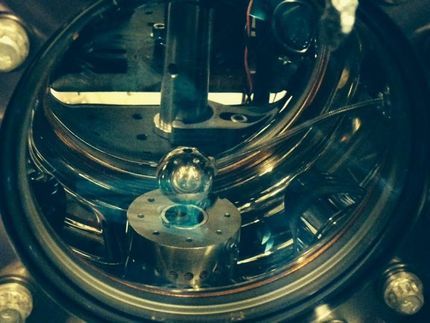DESI, an ambitious probe of dark energy, achieves its next major milestone
Advertisement
DESI, the dark energy Spectroscopic Instrument, is an exceptional apparatus designed to improve our understanding of the role of dark energy in the expansion history of the universe; it will do this by measuring the redshifts of more than 30 million galaxies and quasars, with unprecedented precision. The U.S. Department of Energy has announced its approval of Critical Decision 2 (CD-2), authorizing the project's scientific scope, schedule, and funding profile.

The Dark Energy Spectroscopic Instrument (DESI) will be mounted on the 4-Meter Mayall telescope at Kitt Peak National Observatory. It will collect spectra from 30 million galaxies and quasars to make the biggest 3-D map of the universe ever.
R. Lafever and J. Moustakas for the DESI Collaboration, background image by Dark Energy Camera Legacy Survey.
Two hundred physicists and astronomers make up the international DESI Collaboration, which is based at DOE's Lawrence Berkeley National Laboratory (Berkeley Lab). Using DESI's redshift data they will create a three-dimensional map of the universe reaching deeper in space and time than any yet made. The map will reveal how dark energy and gravity have competed over time to shape the structure of the universe--both the regular clustering of galaxies and dark matter on the largest scales, and the idiosyncratic motion of individual galaxies.
DESI Director Michael Levi, of Berkeley Lab's Physics Division, says, "We'll study four kinds of targets to gather a continuous range of redshifts: nearby bright galaxies to redshift 0.4; luminous red galaxies to redshift 1; emission line galaxies to redshift 1.6; and very distant quasars all the way to redshift 3.5."
The DESI instrument will be mounted on the 4-meter Mayall telescope at Kitt Peak National Observatory near Tucson, Arizona.
Temperature differences map early variations in density (sound waves) that subsequently evolved into the clustering of galaxies, intergalactic gas, and dark matter at recurrent intervals throughout space. Called baryon acoustic oscillations (BAO), these regularly spaced clusterings are consistent over time--like a ruler to gauge the universe, with the CMB at one end--allowing direct measures of dark energy's effect on expansion.
Wechsler says BAO is the beginning of what DESI can do. "Because large accumulations of mass have gravitational effects on individual galaxies, known as redshift space distortions, DESI can also test the accuracy of General Relativity, Einstein's theory of gravity."
In related investigations, DESI will "weigh" the total mass of neutrinos in the universe, with a good chance of learning which of the three known kinds of neutrinos is the heaviest. DESI will also compare models of the inflationary epoch, when the universe expanded exponentially within a sliver of a second after the big bang, leaving it extraordinarily uniform in composition.
"The Mayall telescope is built like a battleship," says Natalie Roe, Director of Berkeley Lab's Physics Division and a member the DESI Executive Committee. The telescope's moving weight is 375 tons, and it is "so well engineered it can support this very heavy new instrument "- which weighs five tons -" suspended way up there in the air."
"What's impressed me most over the years since DESI was first proposed is that the technical capability of the instrument is even better than we hoped," says Berkeley Lab's David Schlegel. Schlegel and Brenna Flaugher, of the Fermi National Accelerator Laboratory, are DESI's Project Scientists. "For example, the final design of the robot positioners has very few moving parts - about 25 parts overall, with only two critical connections."
































































